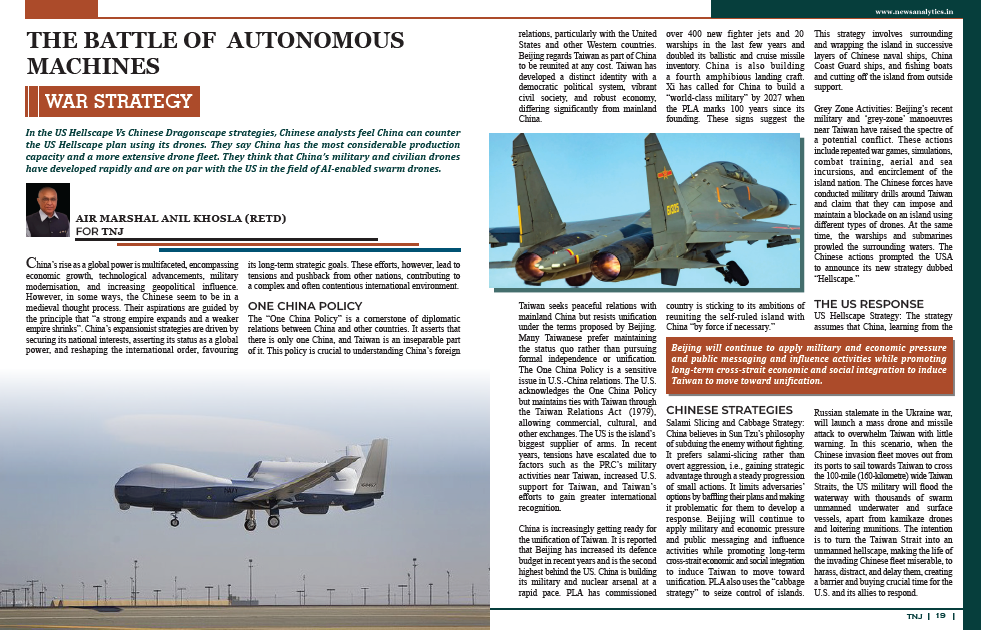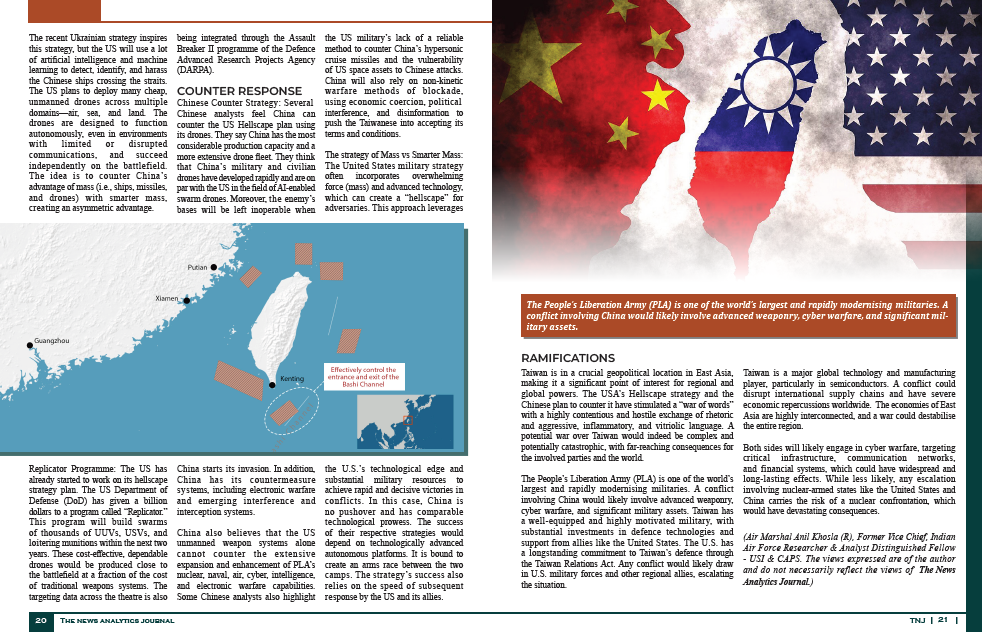
My Article published on the Newsanalytics Journal

China’s rise as a global power is multifaceted, encompassing economic growth, technological advancements, military modernisation, and increasing geopolitical influence. However, in some ways, the Chinese seem to be in a medieval thought process. Their aspirations are guided by the principle that “a strong empire expands and a weaker empire shrinks”. China’s expansionist strategies are driven by securing its national interests, asserting its status as a global power, and reshaping the international order, favouring its long-term strategic goals. These efforts, however, lead to tensions and pushback from other nations, contributing to a complex and often contentious international environment.
One China Policy. The “One China Policy” is a cornerstone of diplomatic relations between China and other countries. It asserts that there is only one China, and Taiwan is an inseparable part of it. This policy is crucial to understanding China’s foreign relations, particularly with the United States and other Western countries. Beijing regards Taiwan as part of China to be reunited at any cost. Taiwan has developed a distinct identity with a democratic political system, vibrant civil society, and robust economy, differing significantly from mainland China. Taiwan seeks peaceful relations with mainland China but resists unification under the terms proposed by Beijing. Many Taiwanese prefer maintaining the status quo rather than pursuing formal independence or unification. The One China Policy is a sensitive issue in U.S.-China relations. The U.S. acknowledges the One China Policy but maintains ties with Taiwan through the Taiwan Relations Act (1979), allowing commercial, cultural, and other exchanges. The US is the island’s biggest supplier of arms. In recent years, tensions have escalated due to factors such as the PRC’s military activities near Taiwan, increased U.S. support for Taiwan, and Taiwan’s efforts to gain greater international recognition.
Unification Plans. China is increasingly getting ready for the unification of Taiwan. It is reported that Beijing has increased its defence budget in recent years and is the second highest behind the US. China is building its military and nuclear arsenal at a rapid pace. PLA has commissioned over 400 new fighter jets and 20 warships in the last few years and doubled its ballistic and cruise missile inventory. China is also building a fourth amphibious landing craft. Xi has called for China to build a “world-class military” by 2027 when the PLA marks 100 years since its founding. These signs suggest the country is sticking to its ambitions of reuniting the self-ruled island with China “by force if necessary.”
Salami Slicing and Cabbage Strategy. China believes in Sun Tzu’s philosophy of subduing the enemy without fighting. It prefers salami-slicing rather than overt aggression, i.e., gaining strategic advantage through a steady progression of small actions. It limits adversaries’ options by baffling their plans and making it problematic for them to develop a response. Beijing will continue to apply military and economic pressure and public messaging and influence activities while promoting long-term cross-strait economic and social integration to induce Taiwan to move toward unification. PLA also uses the “cabbage strategy” to seize control of islands. This strategy involves surrounding and wrapping the island in successive layers of Chinese naval ships, China Coast Guard ships, and fishing boats and cutting off the island from outside support.
Grey Zone Activities. Beijing’s recent military and ‘grey-zone’ manoeuvres near Taiwan have raised the spectre of a potential conflict. These actions include repeated war games, simulations, combat training, aerial and sea incursions, and encirclement of the island nation. The Chinese forces have conducted military drills around Taiwan and claim that they can impose and maintain a blockade on an island using different types of drones. At the same time, the warships and submarines prowled the surrounding waters. The Chinese actions prompted the USA to announce its new strategy dubbed “Hellscape.”

US Hellscape Strategy. The strategy assumes that China, learning from the Russian stalemate in the Ukraine war, will launch a mass drone and missile attack to overwhelm Taiwan with little warning. In this scenario, when the Chinese invasion fleet moves out from its ports to sail towards Taiwan to cross the 100-mile (160-kilometre) wide Taiwan Straits, the US military will flood the waterway with thousands of swarm unmanned underwater and surface vessels, apart from kamikaze drones and loitering munitions. The intention is to turn the Taiwan Strait into an unmanned hellscape, making the life of the invading Chinese fleet miserable, to harass, distract, and delay them, creating a barrier and buying crucial time for the U.S. and its allies to respond. The recent Ukrainian strategy inspires this strategy, but the US will use a lot of artificial intelligence and machine learning to detect, identify, and harass the Chinese ships crossing the straits. The US plans to deploy many cheap, unmanned drones across multiple domains—air, sea, and land. The drones are designed to function autonomously, even in environments with limited or disrupted communications, and succeed independently on the battlefield. The idea is to counter China’s advantage of mass (i.e., ships, missiles, and drones) with smarter mass, creating an asymmetric advantage.
Replicator Programme. The US has already started to work on its hellscape strategy plan. The US Department of Defense (DoD) has given a billion dollars to a program called “Replicator.” This program will build swarms of thousands of UUVs, USVs, and loitering munitions within the next two years. These cost-effective, dependable drones would be produced close to the battlefield at a fraction of the cost of traditional weapons systems. The targeting data across the theatre is also being integrated through the Assault Breaker II programme of the Defence Advanced Research Projects Agency (DARPA).

The strategy of Mass vs Smarter Mass. The United States military strategy often incorporates overwhelming force (mass) and advanced technology, which can create a “hellscape” for adversaries. This approach leverages the U.S.’s technological edge and substantial military resources to achieve rapid and decisive victories in conflicts. In this case, China is no pushover and has comparable technological prowess. The success of their respective strategies would depend on technologically advanced autonomous platforms. It is bound to create an arms race between the two camps. The strategy’s success also relies on the speed of subsequent response by the US and its allies.
Ramifications. Taiwan is in a crucial geopolitical location in East Asia, making it a significant point of interest for regional and global powers. The USA’s Hellscape strategy and the Chinese plan to counter it have stimulated a “war of words” with a highly contentious and hostile exchange of rhetoric and aggressive, inflammatory, and vitriolic language. A potential war over Taiwan would indeed be complex and potentially catastrophic, with far-reaching consequences for the involved parties and the world.
-
- The People’s Liberation Army (PLA) is one of the world’s largest and rapidly modernising militaries. A conflict involving China would likely involve advanced weaponry, cyber warfare, and significant military assets. Taiwan has a well-equipped and highly motivated military, with substantial investments in defence technologies and support from allies like the United States. The U.S. has a longstanding commitment to Taiwan’s defence through the Taiwan Relations Act. Any conflict would likely draw in U.S. military forces and other regional allies, escalating the situation.
-
- Taiwan is a major global technology and manufacturing player, particularly in semiconductors. A conflict could disrupt international supply chains and have severe economic repercussions worldwide. The economies of East Asia are highly interconnected, and a war could destabilise the entire region.
-
- Both sides will likely engage in cyber warfare, targeting critical infrastructure, communication networks, and financial systems, which could have widespread and long-lasting effects.
-
- While less likely, any escalation involving nuclear-armed states like the United States and China carries the risk of a nuclear confrontation, which would have devastating consequences.




Suggestions and value additions are most welcome.
For regular updates, please register here:-
References and credits
To all the online sites and channels.
- Swarajya Staff, “Can China Counter United States’ ‘Hellscape’ Plan When Invading Taiwan?” Swarajya website, 13 Jun 2024.
- FP Staff, ”What is the ‘Hellscape’ strategy the US is planning to use on China if it invades Taiwan?” First Post website, 11 Jun 2024.
- Keoni Everington, “US plans ‘hellscape’ of drones if China invades Taiwan”, Taiwan News website, 11 Jun 2024.
- John Grady, “‘Hellscape’ Swarms Could Be as Cost Effective Taiwan Defense”, USNI News, 02 July 2024.
- Joe Saballa, “China ‘on Track’ for Potential Taiwan Invasion by 2027”, The Defence Post website, 22 Mar 2024.
- Jesse Johnson, “China on track to be ready to invade Taiwan by 2027,” The Japan Times website, 21 March 2024.
- Abhinav Singh, “China plans to use drones to blockade Taiwan after the US unveils ‘Hellscape’ strategy”, Wion website, 07 Jul 2024.
- Ujjwal Shrotryia, “US Has A Nasty Surprise For China If It Tries To Invade Taiwan — Hellscape”, Swarajya website, 11 Jun 24.
Disclaimer:
Information and data included in the blog are for educational & non-commercial purposes only and have been carefully adapted, excerpted, or edited from reliable and accurate sources. All copyrighted material belongs to respective owners and is provided only for wider dissemination.
